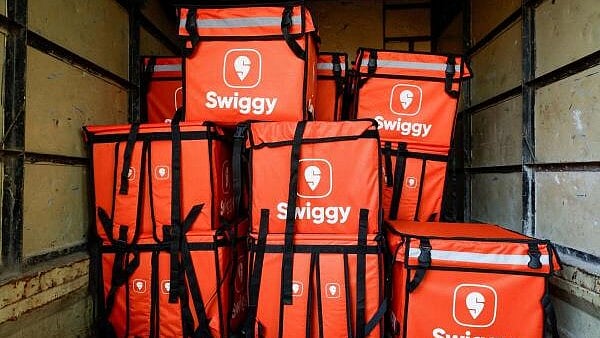
Swiggy delivery bags are stored inside a truck in Mumbai. (Representative image)
Credit: Reuters File Photo
Bengaluru: With Swiggy's board approving the proposal to raise funds up to Rs 10,000 crore through the qualified institutional placement (QIP), the food and grocery delivery major plans to use the funds more towards growth as well as strategic reserves. This fund raise comes a year after the IPO, and people in the know said that this will fuel growth across its quick commerce arm, Instamart, as well as its food delivery business.
Also, this capital is being raised at a time when there is intense competition in the quick commerce space. Zomato's Blinkit and Zepto are pumping in more money to increase the number of dark stores ( a distribution centre exclusively to fulfil online orders for quick delivery).
"Over the last three quarters and post our IPO, the quick commerce business is where most of our investments have gone. The food delivery business, of course, has continued its path of profitable growth and is currently at a run rate of Rs 1,000 crore on an annual basis. And in quick commerce, this is the third continuous quarter of us delivering 100% plus GOV (gross order value) growth," Swiggy's CFO Rahul Bothra said during the company's Q2 earnings call.
Credit: Special Arrangement
He added that this additional capital would be more towards growth, as well as strategic reserves that the platform wants to use going forward.
Swiggy has also made sufficient network investments in the quick commerce business.
Somdutta Singh, Serial Entrepreneur, Founder and CEO, Assiduus Global, said Swiggy has built an interesting place for itself in the country's commerce story. "When people open an app several times a week, it naturally becomes part of their routine. That is what Swiggy has. Food delivery created the habit, and Instamart tapped into that habit for groceries and small everyday items. This puts Swiggy in a good position to influence how quick commerce grows in India. The new fundraise gives them room to improve the basics."
Blinkit and Zepto have pushed expectations on speed and availability, so Swiggy will have to stay sharp, she said.
Last month, Zepto announced the closure of $450 million in recent funding, which was a mix of primary and secondary transactions, with a majority in primary.
Aadit Palicha, CEO & Co-founder at Zepto, had said that they have now about $900 million of net cash in the bank and are more than well-capitalised for the future.
In quick commerce, Zomato's NOV (net order value) growth accelerated to 137% YoY, which is the highest in the last 10 quarters. Its network expansion continued with 272 net new stores, taking the total store count to 1,816 stores.
Bernstein Research in its latest report, mentioned that quick commerce will remain intensely competitive and that food delivery is the cash machine.
In his letter to shareholders, Sriharsha Majety, co-founder, MD & Group CEO, Swiggy, said quick commerce business delivered a 108% YoY GOV growth, clocking a GOV of Rs 7,022 crore.
"With very strong trends in consumer adoption of quick commerce for new categories and purchase missions, these helped further accelerate Instamart’s GOV growth to 24.2% QoQ, the highest in 3 years. Importantly, this acceleration has been achieved with only 40 dark stores being added QoQ (to reach 1102 stores covering 4.6 mn sq ft, across 128 cities)," the co-founder said.
He added that they will continue to sweat its already-established dark store footprint (which can support more than 2X the current order base), while adding stores to de-bottleneck capacity or selectively add coverage in specific hyperlocal zones; rather than expanding significantly into the long-tail of smaller cities in the near-term.